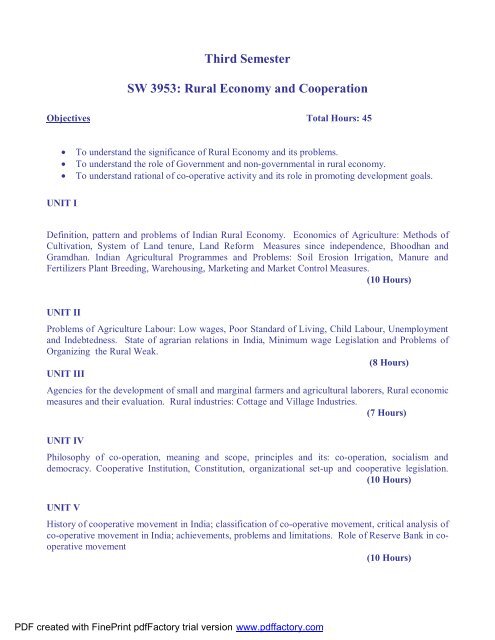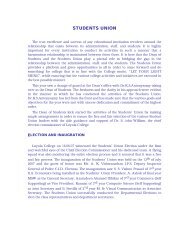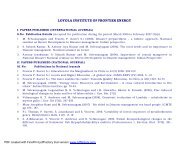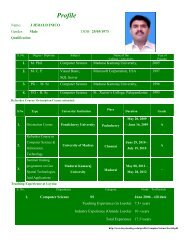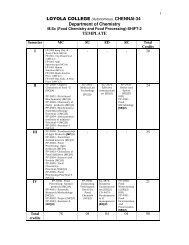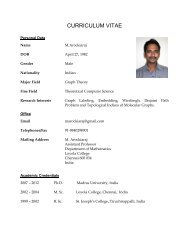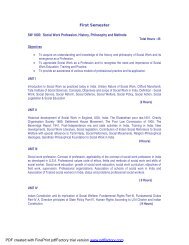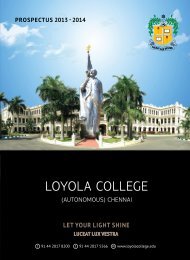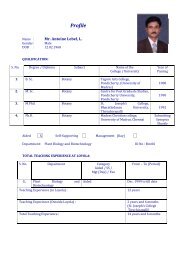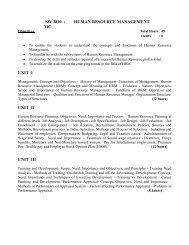Rural Economy and Cooperation - Loyola College
Rural Economy and Cooperation - Loyola College
Rural Economy and Cooperation - Loyola College
Create successful ePaper yourself
Turn your PDF publications into a flip-book with our unique Google optimized e-Paper software.
Third SemesterSW 3953: <strong>Rural</strong> <strong>Economy</strong> <strong>and</strong> <strong>Cooperation</strong>Objectives Total Hours: 45• To underst<strong>and</strong> the significance of <strong>Rural</strong> <strong>Economy</strong> <strong>and</strong> its problems.• To underst<strong>and</strong> the role of Government <strong>and</strong> non-governmental in rural economy.• To underst<strong>and</strong> rational of co-operative activity <strong>and</strong> its role in promoting development goals.UNIT IDefinition, pattern <strong>and</strong> problems of Indian <strong>Rural</strong> <strong>Economy</strong>. Economics of Agriculture: Methods ofCultivation, System of L<strong>and</strong> tenure, L<strong>and</strong> Reform Measures since independence, Bhoodhan <strong>and</strong>Gramdhan. Indian Agricultural Programmes <strong>and</strong> Problems: Soil Erosion Irrigation, Manure <strong>and</strong>Fertilizers Plant Breeding, Warehousing, Marketing <strong>and</strong> Market Control Measures.(10 Hours)UNIT IIProblems of Agriculture Labour: Low wages, Poor St<strong>and</strong>ard of Living, Child Labour, Unemployment<strong>and</strong> Indebtedness. State of agrarian relations in India, Minimum wage Legislation <strong>and</strong> Problems ofOrganizing the <strong>Rural</strong> Weak.(8 Hours)UNIT IIIAgencies for the development of small <strong>and</strong> marginal farmers <strong>and</strong> agricultural laborers, <strong>Rural</strong> economicmeasures <strong>and</strong> their evaluation. <strong>Rural</strong> industries: Cottage <strong>and</strong> Village Industries.(7 Hours)UNIT IVPhilosophy of co-operation, meaning <strong>and</strong> scope, principles <strong>and</strong> its: co-operation, socialism <strong>and</strong>democracy. Cooperative Institution, Constitution, organizational set-up <strong>and</strong> cooperative legislation.(10 Hours)UNIT VHistory of cooperative movement in India; classification of co-operative movement, critical analysis ofco-operative movement in India; achievements, problems <strong>and</strong> limitations. Role of Reserve Bank in cooperativemovement(10 Hours)PDF created with FinePrint pdfFactory trial version www.pdffactory.com
References:1. Agarwal, A.N,2001 Indian <strong>Economy</strong>: Nature, Problem & Progress, Vikas PublishingHouse, New Delhi.2. Alak Ghosh, 1984 Indian <strong>Economy</strong>, Asian Publication, New Delhi.3. Bansil, P.C, 1981 Agricultural problems of India, Vikas Publishing House, NewDelhi.4. Bagai Krishnan, 2000 The Cooperative Movement in India, Vijaya Press, New Delhi5. Dutt &Sundaram,2006 Indian <strong>Economy</strong>, Sultan & Ch<strong>and</strong>, New Delhi.6. Kishen, Ram, 2003 Management of Co-operatives, Jaico Publishing House, Mumbai.7. Mathur.B,1998 Co-operative in India: A Critical analysis of the Co-operativemovement in India’s planned economy, Sahityat Bhavan, Agra8. Sankaran, S, 1981 Economic development of India, Progressive Co-operation,Bombay.9. Tyagi, R. B., 1968 Recent trends in Co-operative movements in India, AsiaPublishing House, New Delhi.PDF created with FinePrint pdfFactory trial version www.pdffactory.com
SW 3954 : <strong>Rural</strong> Community DevelopmentObjectives: Total Hours: 45• To underst<strong>and</strong> the meaning <strong>and</strong> problems of rural community development.• To underst<strong>and</strong> the history, philosophy, principles, objectives <strong>and</strong> skills of rural communitydevelopment.• To appreciate the role of various stakeholders of rural developmentUNIT I<strong>Rural</strong> societies in India- Indian village as a community - Family, Caste <strong>and</strong> Occupation, <strong>Rural</strong> powerstructure - Economic, Political <strong>and</strong> Social; Analysis of <strong>Rural</strong> Problems - Poverty, Unemployment, Illhealth, Shelter, Migration <strong>and</strong> Illiteracy.(8 hours)UNIT IIConcepts of <strong>Rural</strong> Community - <strong>Rural</strong> Development. <strong>Rural</strong> Community Development - definition,concepts, philosophy, objectives <strong>and</strong> scope. Models <strong>and</strong> Approaches to <strong>Rural</strong> CommunityDevelopment.UNIT III(8 Hours)History of <strong>Rural</strong> Community Development in India - Early pioneering period - Sriniketan,Marth<strong>and</strong>am, Gurgaon <strong>and</strong> G<strong>and</strong>hiji Wardha project <strong>and</strong> Post Independence period. Five Year Plans<strong>and</strong> <strong>Rural</strong> Community Development. Impact of Globalisation on <strong>Rural</strong> Development. Right toInformation on <strong>Rural</strong> Development.( 9 Hours)UNIT IVCommunity Development Administration - Organization <strong>and</strong> administration of CommunityDevelopment from Village to National levels - Components of Block Administration, developmentprogrammes <strong>and</strong> their co-ordination. Functions of BDO <strong>and</strong> other functionaries, Training <strong>and</strong> capacitybuilding of <strong>Rural</strong> Development Workers <strong>and</strong> E-Governance in <strong>Rural</strong> Development. Concept ofDemocratic Decentralization – Panchayati Systems <strong>and</strong> Historical perspectives in Local SelfGovernment, Balwantrai Mehta Committee Report, 73rd Amendment of Constitution, Three TierSystem administrative set-up <strong>and</strong> functions - finance, elections <strong>and</strong> problems of Panchayati Raj, TamilNadu Panchayat Act, 1995.( 10 Hours)PDF created with FinePrint pdfFactory trial version www.pdffactory.com
UNIT VRole of Self-Help Groups, Commercial Banks, <strong>Rural</strong> Banks, Industries, Non-Governmental Bodies(National <strong>and</strong> International), WTO, World Bank, IMF <strong>and</strong> United Nations Bodies in <strong>Rural</strong> CommunityDevelopment. Role <strong>and</strong> skills of a Community Development Worker – identification <strong>and</strong> working withleaders, resource mobilization, organizing people, working in groups, networking, influencingPanchayat bodies, lobbying <strong>and</strong> advocacy.(10 Hours)References:1. Agarwal , A.N., 2001 Indian <strong>Economy</strong>; Nature, Problems <strong>and</strong> Progress , Vikas BirajPraksah, New Delhi2. Chambers.R, 1983 <strong>Rural</strong> Development: Putting the Last First, Harlow, Longman,3. Datt & Sundaram,2002 Indian <strong>Economy</strong>, S. Ch<strong>and</strong> & Co., New Delhi,4. Desai A.R,1995 <strong>Rural</strong> Sociology in India, ISAE, Bombay.5. Douglas, Ensminger,1960 A Guide to Community Development, Ministry ofCommunity Development.6. Dube.S.C,1965 India’s changing Villages, Rutledge <strong>and</strong> Kegan Paul,London.7. Dubhashi, P.R.,2000 <strong>Rural</strong> Development Adminstration in India, Mumbai.8. Jain, S.C. ,1998 Community development <strong>and</strong> Panchayat Raj in India, AlliedPublishers Ltd., Chennai-29. Jain, S.C.,1998 <strong>Rural</strong> Development Institute <strong>and</strong> Strategies, Raws Publications,New Delhi.10. Katar Singh, 1986 <strong>Rural</strong> Development – Principles, Policies <strong>and</strong> Management, SagePublications, New Delhi.12. Riley John .M,1995 Stakeholders in <strong>Rural</strong> Development, Sage Publications, NewDelhi.13. Sachin<strong>and</strong>a <strong>and</strong> Purnendu, 2001 Fifty Years of <strong>Rural</strong> Development in India, Firma KLM Pvt Ltd.,Kolkata.PDF created with FinePrint pdfFactory trial version www.pdffactory.com
SW 3955/ 3984 : Welfare of Weaker SectionsObjectives: Total Hours: 45UNIT I• To expose the students to the reality of the dispossessed sections of the society• To facilitate an underst<strong>and</strong>ing of the social <strong>and</strong> political factors that influence the weakersections• To provide an analytical perspective of the issues involved in the weaker sections.Societal processes – Socialization, Socialized Self, Social Control <strong>and</strong> Group Formation, SocialInequality, Social Stratification, Race, Ethnicity, Inequality in the Indian context(8 Hours)UNIT IIDisadvantaged Sections: Identifying the Weaker Sections, concept <strong>and</strong> definition of Welfare, lookingthrough the lenses of the Disadvantaged Sections, classification of the Weaker Sections, background,context, legal classification <strong>and</strong> its consequences(10 Hours)UNIT IIIDisadvantaged Sections a Sectoral Approach; An analysis of the situation of Dalits, Tribals, Women,L<strong>and</strong>less Laborers <strong>and</strong> Minorities(8 Hours)UNIT IVLaws <strong>and</strong> welfare measures for the Weaker Sections, Protective Discrimination, approaches for thewelfare/development/empowerment of the Disadvantaged Sections- Program Planning <strong>and</strong> relatedissues - budget, social policy, <strong>and</strong> the politics of welfare planning.(10 Hours)UNIT VSocial Work Interventions: Case Studies <strong>and</strong> Models for the upliftment of the DisadvantagedSections. Reformers: Phule, Ambedkar, Periyar, Pundit Ayothidass <strong>and</strong> other contemporary reformers.( 9 Hours)PDF created with FinePrint pdfFactory trial version www.pdffactory.com
References:1. Ambedkar, B.R, 1987 “Annihilation of Caste” Dr.B.R. Ambedkar -“Writing <strong>and</strong> Speeches” The EducationDepartment, Government of Maharashtra,Mumbai.2. Beteille, Andre. 1996 Caste, Class <strong>and</strong> Power: Changing Patterns ofStratification in a Tanjore Village, OxfordUniversity Press, Delhi.3. Ghurye, GS ,1961 Caste, Class <strong>and</strong> Occupation, Popular BookDepot, Bombay.4. Ilaiah. Kancha 1996 Why I Am Not A Hindu, Samya publications,Calcutta5. Louis, Prakash, 2003 The Political Sociology of Dalit Assertion,Gyan, New Delhi6. Michael, S,M., ed., 1999 Dalits in Modern India, Vision <strong>and</strong> Values,New Delhi.7. Thurston. E (assisted by K. Rangachari)1909,The Tribes <strong>and</strong> Castes of South India,Government Press, Madras.8. Yadav , 2004 Encyclopedia of Scheduled Castes <strong>and</strong>Scheduled Tribes, Anmol Publications, NewDelhi.Reports :1. Tamil Nadu Social Development Report, 2000, Tamil Nadu Peoples Forum for Socialdevelopment, Chennai.2. National Human Development Report 2001, Government of India, New Delhi.3. Social Development Report. 2006, Oxford University Press, New Delhi,Journals : Social Action, Indian Journal of Development & Indian Journal of Social WorkPeriodicals : Economical <strong>and</strong> Political Weekly, Mainstream, Kurukshetra, Social WelfareHimal , Dalit Voice & Communalism CombatPDF created with FinePrint pdfFactory trial version www.pdffactory.com
SW 3964: Industrial Relations & Trade UnionObjectives :Total Hours : 45 Hours• To underst<strong>and</strong> the basic concepts of Industrial Relations.• To develop a holistic underst<strong>and</strong>ing of the functioning of the Industrial Relations System• To familiarize with the recent trends in Industrial Relations.UNIT IIndustrial Relations: meaning, concepts, Historical Development, influence of Socio-economic <strong>and</strong>political forces on Industrial Relations.(9 Hours)UNIT IIIndustrial Relations at Shop Floor <strong>and</strong> Plant Levels, discipline, domestic enquiry, GrievanceSettlement Procedure, Recognition of Trade Unions.(9 Hours)UNIT IIICollective Bargaining : meaning, theories, Pre requisites, Principle, Strategies, Skills, Subject matterfor Collective Bargaining, Factors influencing Collective Bargaining, Administration of CollectiveAgreements, Problems pertaining to Collective Bargaining in India(9 Hours)UNIT IVIndustrial Relations at Government level: Role of State in regulating Industrial Relations,Government’s Labour policy. Bipartite <strong>and</strong> Tripartite approaches to industrial Relations; Workers’Participation in Management – meaning – works committee – joint production committee – jointmanagement councils. Labour Movement in UK <strong>and</strong> USA.(9 Hours)UNIT VLabour Movement <strong>and</strong> Trade Unionism in India : Historical development of Trade Union in India,present state of Trade Unionism in India , major central Trade Union organizations: Membership,Finance structure , Leadership , Politics, Trade Union rivalry & Violence- International LabourOrganization : history, objectives, structure, functions, achievements & impact of I.L.O. on LabourLegislations & Labour Policies in India.(9 Hours)PDF created with FinePrint pdfFactory trial version www.pdffactory.com
References :1. Ahuja .K.K., 1990 Industrial Relations theory & Practice, Kalyanipublishers, Ludhiana2. Bhatia.SK, 1988 Personnel Management & Industrial Relations,Deep&Deep Publications, New Delhi.3. Gupta. C.B, 2000 Industrial Relations & Labour Laws, Sultanch<strong>and</strong>,New Delhi.4.Mamoria. C.B, 2000Dynamics of Industrial Relations, Himalaya publishers,Mumbai.5. Misra.S.N., 1986 Labour & Industrial Laws, Allahabad Book Agency,Allahabad6. Monappa , Arun , 2005 Industrial Relations, Tata McGraw Hill Book,New Delhi.7. Sarma. A.M, 2000 Industrial Relations: Conceptual <strong>and</strong> Legal Frame workHimalaya publishers, Mumbai.8. Subramanian, 2002 Labour Management Relations in India,Asia publishing house, Chennai.9. Tiwari.R.S.1999 New challenges in Industrial Relations, Tamil NaduBook house, chennai.10. Tripathi. PC, 1998 Industrial Relations & Labour Laws, Sultanch<strong>and</strong>publication, New DelhiReports1. Govt. of India Report of the study group on worker participation inManagement.2. Govt of India Report of the National Commission on Labour (1969).PDF created with FinePrint pdfFactory trial version www.pdffactory.com
SW 3965 : Labour Legislations <strong>and</strong> Case LawsObjectives : Total Hours : 45UNIT I• To familiarize with the evolution of Labour Legislations in the context of IndianConstitution <strong>and</strong> International Conventions.• To develop an in-depth underst<strong>and</strong>ing of relevant Labour Legislations.• To impart analytical skills in the interpretation of legislations in the light of recentjudgments.History of labour legislations in India- Labour in the Indian Constitution -International Labour Code -(ILC) - Judicial set-up <strong>and</strong> administration of industrial <strong>and</strong> labour judiciary- Administrative set-up <strong>and</strong>functions of the factory inspectorate.(9 Hours)UNIT IIFactories Act, 1948.- Indian Mines Act, 1952.- Plantations labour Act, 1951.- Motor TransportWorkers Act, 1961.- Industrial employment (St<strong>and</strong>ing orders) Act, 1946.- Apprentices Act, 1961. -Employment Exchange (Compulsory notification of vacancies) Act, 1959.- Contract labour(Regulations <strong>and</strong> Abolition) Act, 1970.( 9 Hours)UNIT IIIPayment of Wages Act, 1936.- Minimum wages Act, 1948.- Payment of Bonus Act, 1965. - Socialsecurity legislation : Workmen’s Compensation Act, 1923.- Employee’s State Insurance Act, 1948. -Employee’s Provident Fund <strong>and</strong> Miscellaneous Provisions Act, 1952. - Maternity Benefit Act, 1961.-Payment of Gratuity Act, 1972.(9 Hours)UNIT IVTrade Unions Act, 1926 - Industrial Disputes Act, 1947.(9 Hours)UNIT VTamil Nadu Shops <strong>and</strong> Establishments Act, 1947. Tamil Nadu Catering Establishments Act, 1958. -The Tamil Nadu Industrial Establishment (conferment of permanent Status to Workmen) Act, 1981.-The Tamil Nadu Payment of Subsistence Allowance Act, 1981. - Tamil Nadu Industrial Establishment(National <strong>and</strong> Festival Holidays) Act, 1951.- Tamil Nadu Labour Welfare Fund Act, 1972.(9 Hours)Important NoteCurrent Bills, new Case Laws <strong>and</strong> new Laws should form part of the syllabus automatically.PDF created with FinePrint pdfFactory trial version www.pdffactory.com
References1. Garg, Ajay, 2007 Labour Laws one should know, A Nabhi Publications, NewDelhi.2. Gupta. C.B, 2000 Industrial Relations & Labour Laws, Sultanch<strong>and</strong>,New Delhi.3. D.P.Jain, 1991 Industrial Law, Konar publication, New Delhi.4. Kapoor. N.D, 2006 H<strong>and</strong>book of Industrial Laws, Sultanch<strong>and</strong>,New Delhi.5. Malhotra. O.P, 1998 The Laws of Industrial Disputes, Universal Lawpublishing company, New Delhi.6. Misra, S. L. , 1983 Labour <strong>and</strong> Industrial Laws, Pioneer publication,New Delhi.7. Srivastava,S.C, 2000 Industrial Relations <strong>and</strong> Labour Laws,Vikas publishing House, New Delhi.8. Subramaninan, 1998 Factory Laws applicable in Tamil Nadu, MadrasBook agency, Chennai.9. Tripathi. PC, 1998 Industrial Relations & Labour Laws, Sultanch<strong>and</strong>Publication, New DelhiPDF created with FinePrint pdfFactory trial version www.pdffactory.com
SW 3966 : Human Resource ManagementObjectives: Total Hours : 45• To underst<strong>and</strong> the basic concepts of Human Resource Management.• To familiarize with the sub systems of Human Resource Management• To interpret Human Resource functions with the strategic management processUNIT IManagement: Introduction, History of Management, Schools of Management Thought, Functions ofManagement; Planning, Organizing, Staffing, Directing, Coordinating, Reporting <strong>and</strong> Budgeting-Recent trends in Management: Corporate Social Responsibility, Benchmarking, QualityManagement, Six Sigma, Core Competency <strong>and</strong> Outsourcing- Human Resource Management(HRM): Importance of Human Resources in an organization, Traditional <strong>and</strong> modern approaches tomanaging people, Diversity of Work Force, Importance of Human Relations in organizations,Functions of HRM; Procurement, Maintenance, Development, Integration <strong>and</strong> Separation ofEmployees; Strategic Human Resource Management- Organization Structure: Types of Structures;Tall versus Flat Structures, Organic versus Mechanistic Structures, Matrix Structure, De-layering <strong>and</strong>Re-structuring(12 hours)UNIT IIHuman Resource Planning: Personnel Policies, Forecast of Human Resource, Skill Inventory, Time<strong>and</strong> Motion Study, Job Analysis, Job Description, Job Specification <strong>and</strong> Composition of Personnel,Designing jobs according to skill-sets of individuals, Skill redundancy <strong>and</strong> redeployment-Recruitment: Recruitment Policies, Methods <strong>and</strong> Sources, Use of Application Blanks, Advertisementsfor Recruitment, On-line Recruiting <strong>and</strong> Recruitment Consultants, Cost-efficiency <strong>and</strong> Effectiveness inRecruitment, Recruitment of Part-time employees, freelancers <strong>and</strong> contract staff- Selection: Criteriafor Selection, Methods of Selection, Written Tests, Interviews, Reference Checks, Verification oftestimonials, Instruments for measurement; Selection-Ratio, Job Titles, Placement <strong>and</strong> Induction-Compensation: Salary Survey, Designing compensation packages- Basic, Dearness Allowance <strong>and</strong>other allowances; Determinants of pay <strong>and</strong> perquisites, Incentives, Salary negotiations; Pay forInternational employment, Premium Pay, flexible pay <strong>and</strong> Employee Stock Options (ESOP).(12 hours)UNIT IIIPerformance Appraisal: Meaning, Purpose, Methods of Appraisal <strong>and</strong> their relevance, RankingMethod, Rating Method, Paired Comparison, Free Essay, Forced Choice, Critical Incidents, KeyResult Areas, Human Resource Accounting, Management By Objectives (MBO), 360* Appraisal,Process of Designing Appraisals, Problems in Performance Appraisal. (7 hours)PDF created with FinePrint pdfFactory trial version www.pdffactory.com
UNIT IVTraining <strong>and</strong> Development: Definition, need <strong>and</strong> Scope of Training, Training Need Analysis,Assessment of Return-on- Investment (ROI) on training; Methods of training, On-the-Job Training,Coaching, Mentoring, Management Games, Case Study, Internships, Role Plays, Job Rotation,Programmed Instruction, Simulation Training, Vestibule Training, Out-Bound Training (OBT) <strong>and</strong>Computer based Training; Training for workers, supervisors <strong>and</strong> managers.(8 hours)UNIT VRetention <strong>and</strong> Separation of employees: Employee-turnover <strong>and</strong> retention, Causes of Separation,Retirement on Super-annuation, Resignation, Retrenchment, Voluntary Retirement Schemes,Dismissal, Exit Interviews <strong>and</strong> settlement of dues.(6 hours)References:1. Koontz <strong>and</strong> Weihrich, 1980, Essentials of Management. McGraw Hill, New York2. C.B. Mamoria, 1996 Personnel Management: Himalayan Publications, NewDelhi3. Mondy, Robert.& Shane, 1996 Human Resource Management, Prentice Hall, New Delhi4. Pigors <strong>and</strong> Myers, 1993 Personnel Management, McGraw Hill, New York5. Rao T. V, 2000 Human Resource Development, Sage Publications, NewDelhi6. V.S.P. Rao , 2000 Human Resource Management:, Sage Publications, NewDelhi.7. P.C. Tripathi , 1999 Principles of Management, Tata McGraw Hill, Mumbai.PDF created with FinePrint pdfFactory trial version www.pdffactory.com
SW 3973: Medical Social Work in IndiaObjectives: Total Hours: 45• To enable the students to develop appropriate values, knowledge, skills <strong>and</strong> techniques foreffective Social Work practice in the field of Health.• To enable the students to underst<strong>and</strong> the psycho- socio- cultural realities associated with patientcare in the Hospital <strong>and</strong> Community setting.• To acquire the knowledge with respect to the inter-disciplinary approach for persons withdisease <strong>and</strong> disability.UNIT IMedical Social Work: Definition <strong>and</strong> Objectives, Historical Development of Medical Social Work inthe West <strong>and</strong> in India, Need for Medical Social Work in our Country, Current trends in Medical SocialWork in India- Medical Sociology: Definition <strong>and</strong> important concepts, Relevance of MedicalSociology <strong>and</strong> its Practice of Medical Social Work- Concept of patient as a person : Patient as awhole, Social Assessment of patient’s family, Preparation of Social Case Work history(With examplesfrom field work practice), Patient’s Rights <strong>and</strong> Medical Ethics, Psycho-Social Problems of patients <strong>and</strong>families during the process of treatment <strong>and</strong> hospitalization, Palliative care <strong>and</strong> Pain Management.(10 Hours)UNIT IIConcept of long term hospitalization: Impact of long term hospitalization on the patients <strong>and</strong> thefamilies- Role <strong>and</strong> Functions of Medical Social Worker : <strong>Rural</strong> <strong>and</strong> Urban Community Settings,Promoting health needs <strong>and</strong> functions, Maternity <strong>and</strong> Children’s Hospital, Cancer, Chronic Illness(Diabetes, Nephritises, Cardio-Vascular Disorders, HIV/ AIDS, Tuberculosis) Blood Bank, OrganTransplant Centers, Trauma Care Centers, Hospice settings, NGOs managing Health Services <strong>and</strong>Hospitals.(10 Hours)UNIT IIIConcept of disability: Causes, Management <strong>and</strong> Rehabilitation of Physical Disabilities-Rehabilitation: Definition, Objectives, Principles, Approaches <strong>and</strong> Models- Multi Disciplinaryapproaches in Medical Social Work: Importance of Team Work <strong>and</strong> Case Conference, Role of theMedical Social Worker(9 Hours)UNIT IVOrganisation <strong>and</strong> Administration of Medical Social Work in a Hospital Setting- Role of the MedicalSocial Workers in the Department- Staff Developmental Programmes for Medical Social Workers-Application of various Social Work Methods in Hospital Setting- Specific skills required for MedicalSocial Work Practice.(8 Hours)PDF created with FinePrint pdfFactory trial version www.pdffactory.com
UNIT VField work in the Medical Social Work Practices- Role of the trainee- Importance of Supervision-Evaluating the current trends in the Field Work practices- Measures to strengthen Field Work practice-Inter- Disciplinary Studies Medical Social Work Research.( 8 Hours)References:1. Ahuja, Ram, 2006 Social Problems in India, Rawat Publication, New Delhi.2. Blaxter, Mildred, 2004 Key Concepts on Health, Polity Publishers, New Delhi3. Bradshaw & Bradshaw, 2004 Health Policy for Health Care Professional, SagePublications, New Delhi.4. Brannon& Feist, 2000 Health Psychology, TLARC Publication, Toronto.5. Dowding & Barr, 2002 Managing in Health Care, Pearson Education Ltd.,London6. Dziegielewski, Sophia, 2003 Changing Phase of Health Care, Social Series IIEducation, Sara book, New Delhi.7. Sarah Ghelert, 2006 H<strong>and</strong> book of Health Social Work, John Wiley & Co.,London8. Sirohi,An<strong>and</strong>, 2005 Modern Perspectives in Social Work, DominantPublishers, New Delhi.9. William C. Cockerham, 1998 Medical Sociology, Prentice Hall,New Jersey.10. Zastrow,Charles, 2000 Introduction to Social Work <strong>and</strong> Social Welfare,Wadsworth Publication, BelmontJournals:• Health Action, CHAI, Secunderabad• Health Care Law, ICFAI, Hyderabad• Health for the Millions, VHAI,New Delhi• Indian Journal of Social Work, TISS, Mumbai• Journal of Indian Council of Medical Research• Social Welfare, CSWB, New DelhiPDF created with FinePrint pdfFactory trial version www.pdffactory.com
SW 3974 : Psychiatric DisordersObjectives : Total Hours : 45• To acquire knowledge of the phenomenology, symptomatology <strong>and</strong> treatment of CommonMental Disorders.• To develop skills in identifying Mental Disorders in Health Care <strong>and</strong> Community settings.• To develop the capacity of the student to apply knowledge <strong>and</strong> skills of the methods ofProfessional Social Work, as a member of the Mental Health Team, in Field Work setting inPsychiatry.UNIT IHistory of Psychiatry, Concept of Normality <strong>and</strong> Abnormality. (5 Hours)UNIT IIPsychiatric Interviewing, Case History Recording <strong>and</strong> Mental Status Examination.(10 Hours)UNIT IIIStudy of the following disorders: Psychoneuroses, Epilepsy, Psychosomatic Disorders, PsychosexualDysfunctions, Sexual Deviations, Psychoses, Psychopathic Personality, Suicide, Alcoholism <strong>and</strong> DrugDependency, Post-Traumatic Stress Disorder.(20 hours)UNIT IVPsychiatric Disorders of Childhood, Mental Retardation.(5 hours)UNIT VThe role of various Socio-cultural factors in Psychiatry.(5 hours)References1. Bhugra , Gopinath, Vikram Patel, 2005 H<strong>and</strong>book of Psychiatry- A South AsianPerspective. Byword Viva Publishers Pvt.Ltd., Mumbai2. Coleman <strong>and</strong> James, 1996 Abnormal Psychology Modern Life: Tarapore Vala <strong>and</strong>Sons, Mumbai.3. Kaplan , Harold, I., Sadock, B.J., 1989. Comprehensive Text Book of Psychiatry, Williams &Wilkins, Baltimore, London.4. Kapur, M., 1995 Mental Health of Indian Children, Sage Publications,New Delhi.5. Mane & G<strong>and</strong>evia, 1998 Mental Health in India: Issues <strong>and</strong> Concerns, TataInstitute of Social Sciences, Mumbai.6. WHO, 2004 The ICD-10 Classification of Mental <strong>and</strong> BehavioralDisorders, Diagnostic Criteria for Research, AITBSPublishers <strong>and</strong> Distributors, DelhiPDF created with FinePrint pdfFactory trial version www.pdffactory.com
SW 3975: Health Situation in IndiaObjectives:Total Hours: 45• To develop an underst<strong>and</strong>ing of multidimensional approach to Health.• To underst<strong>and</strong> the administration of the basic health infrastructure in the country• To relate the knowledge of Social Work practice to the health situation in India.UNIT – IUnderst<strong>and</strong>ing Health- a critical review of various interpretations of health. A brief review of thevarious systems of medicine practised in India. Health status of the people of India with specific focuson marginalized <strong>and</strong> vulnerable groups- A comparative study of rural <strong>and</strong> urban health in India. Socialeconomic <strong>and</strong> cultural factors that influence the health status of individuals, groups <strong>and</strong> communities.(9 Hours)UNIT IIUnderst<strong>and</strong>ing health from the human rights perspective – Environment issues <strong>and</strong> health – Media <strong>and</strong>health – Positive <strong>and</strong> negative factors – Focus on health movements <strong>and</strong> campaigns – Role of theProfessional Social Worker. Legislations pertaining to health – A critical review.(9 Hours)UNIT IIIHealth administration at the National <strong>and</strong> State <strong>and</strong> District levels – Primary Health Centres – structure<strong>and</strong> functions – Corporation <strong>and</strong> Municipal health services. Health policies <strong>and</strong> health planning –Review of current reports on health – Govt. of India <strong>and</strong> Govt. of Tamil Nadu.(9 Hours)UNIT IVPartners in health care – Role of NGOs, health networks, corporate sector, Educational institutions <strong>and</strong>religious institutions – preventive, promotive <strong>and</strong> rehabilitative aspects – a critical analysis.Community health – principles <strong>and</strong> models of intervention – role <strong>and</strong> functions of the ProfessionalSocial Worker – Specific skills required for Medical Social Work practice.(9 Hours)UNIT VCurrent studies on health care <strong>and</strong> health services – A review <strong>and</strong> analysis from scientific journals,health magazines. Latest reports of National <strong>and</strong> International Organisations working in the area ofHealth.PDF created with FinePrint pdfFactory trial version www.pdffactory.com
References :1.Ajit , 2005Social Dimensions of Health, Rawat Publications, New Delhi2. Bajpai, 1998 Social Work Perspectives on Health, Rawat Publications,New Delhi3. Mishra, 2000 Indian Health Report, Oxford University Press, Delhi4. Narayana, 1997 Health <strong>and</strong> Development , Rawat Publications, New Delhi5. Park <strong>and</strong> Park, 2003 Textbook of preventive <strong>and</strong> social medicine6. Pokrana, 1994 Social Beliefs, Cultural Practices in Health <strong>and</strong> Disease ,Rawat Publications, New DelhiWebsiteswww.who.org World Health Reports (1995-22050www.tnhealth.org Annual Reportmohfw.nic.inwww.nfhsindia.orgvhai.orgAnnual ReportNational Family Health Survey, IndiaState of India’s health report, Report of independentcommission on health in India <strong>and</strong> other reportsPDF created with FinePrint pdfFactory trial version www.pdffactory.com
SW 3983 : Children in IndiaObjectives: Total Hours : 45UNIT I• To enable the students to gain a deep underst<strong>and</strong>ing of the psycho-socio, economic <strong>and</strong>cultural factors that influence the lives of children in our country• To help the students to critically review the various policies, programmes <strong>and</strong> servicesavailable for children in India.• To enable the students to develop appropriate skills <strong>and</strong> strategies to effectively work withchildren in different settings.Demographic characteristics <strong>and</strong> disadvantaged children with special reference to India. Child Labourin India – Genesis, rural <strong>and</strong> urban working children employed in organized <strong>and</strong> unorganized sectors,health hazards, working conditions <strong>and</strong> environment, hours of work, wage, services for workingchildren. Children living in street – problems, services, special programs for street children. ChildTrafficking – Magnitude, Precipitating factors –Prevention, Role of Government, Police, NGOs.( 9 Hours)UNIT IIChildren in Difficult circumstances – Children in conflict with Law – Children in Institutions –Refugee <strong>and</strong> displaced children – Child beggars – Children affected by HIV / AIDS – Children of Sexworkers – Ab<strong>and</strong>oned children – Child victims of Terrorism <strong>and</strong> communal violence – Childmarriages. Special care of physically <strong>and</strong> mentally challenged children. – Children with learningdisabilities . Status of the girl child in India – Female infanticide <strong>and</strong> foeticide – Declining sex ratios.( 9 Hours)UNIT IIIChild abuse Magnitude, Precipitating factors, Role of NGOs, Government – Personal safety training.Child Education – Educational scenario, <strong>Rural</strong> – Urban <strong>and</strong> gender differences – Problems in schoolsettings – Child friendly schools initiative. United Nations Charter of Children’s Rights <strong>and</strong>Constitutional directives, Child welfare policies <strong>and</strong> programmes for children – National policy onChild welfare, State plan of Action – Tamil Nadu – Programmes <strong>and</strong> services by NGOs – Child relatednetwork.( 9 Hours)UNIT IVLegislation on Children : The Children (Pledging of Labour) Act 1935 - Employment of Children Act ,1938 - Minimum Wages Act 1948 - Child Labour (Prohibition <strong>and</strong> Regulation ) Act 1986 – JuvenileJustice Act 2001. Child Health Programmes- Immunisation, Nutritional Problems, Specific Childhealth programmes. National <strong>and</strong> State level health programmes – Child related health services offeredby NGOs.( 9 Hours)PDF created with FinePrint pdfFactory trial version www.pdffactory.com
UNIT VRole <strong>and</strong> Functions of Professional Social worker – Family setting, Institutional settings, ChildGuidance Clinic, Children’s hospital , Foster care <strong>and</strong> adoption, Rehabilitation settings. Child helpline services, School Social work – Current research studies in India on Child Rights, Child relatedservices <strong>and</strong> issues – Specific skills required for Social Work intervention with the children.( 9 Hours)Teaching MethodologyLectures, Group Discussion, Group exercises, Field visits, Case studies, Assignments, Seminars,Expert lectures, Role play <strong>and</strong> Psycho Drama <strong>and</strong> sharing of Field work experiences.References :1. A.B.Bose, 2003 The State of Children in India, Manohar publishers,New Delhi.2. Chowdhary, Paul, 2004 Child welfare & Development, Atma Ram & Sons,New Delhi.3. David & Manohar, 2006 International social work, Vistas publication, New Delhi4. Pillai .M.G, 2004 Child Abuse, Pointer publishers, Jaipur5. Rao ,Venakaterwara, 2004 Child Rights, Manak publications, New Delhi..6. S<strong>and</strong>hya, 1996 Child survival health <strong>and</strong> Social work Intervention,Concept publishers, New Delhi.Latest Reports1. Government of India2. Government of Tamil Nadu3. UN Organisations4. Human Rights groups <strong>and</strong> NGOs working with Children.PDF created with FinePrint pdfFactory trial version www.pdffactory.com
SW 3985 : Women <strong>and</strong> DevelopmentObjectives: Total Hours: 45• To enable the students to develop <strong>and</strong> underst<strong>and</strong> the perspectives of Women <strong>and</strong> Developmentin the society <strong>and</strong> to examine the social systems that affect women in meeting growth needs<strong>and</strong> special needs.• To enable the students to develop an ability to identify areas of work with women <strong>and</strong>underst<strong>and</strong>ing the strategies to change a situation in terms of personal liberation as well as inmaking women a part of the developmental process.• To train the students to develop appropriate competence at all the three levels of ProfessionalSocial Work training namely Knowledge, Skill <strong>and</strong> Attitude with specific reference to issuesrelated to women.UNIT IDemographic profile of Indian women: Status of women with specific reference to socio economic,cultural, religious correlates—Education, employment, health <strong>and</strong> political participation—Realities offemale infanticide. Implications of declining sex ratio- Aged women <strong>and</strong> their problems.(10 Hours)UNIT IIWomen’s issues expressed Pre-Independence <strong>and</strong> Post-Independence <strong>and</strong> in the last decade. Changingperspectives of the role of women in families <strong>and</strong> the society with specific reference to India—Religion <strong>and</strong> women- Women <strong>and</strong> employment.(8 Hours)UNIT IIIVarious forms of violence against women—crime against women—statistics, trends <strong>and</strong> types ofexploitation. Needs <strong>and</strong> problems of women- Deserted, destitute, widows, unwed mothers, single,married- Problems of Dalit women, tribal women, rural <strong>and</strong> urban women, women in slumcommunities- Working women <strong>and</strong> their problems—specific focus on women in unorganised sectors.(10 Hours)UNIT IVWomen <strong>and</strong> Mass Media: influence <strong>and</strong> impact of media in society. Women <strong>and</strong> Law: constitutionguarantee, policy relating to reservation for women.(7 Hours)UNIT VWomen’s Movement: local, national, <strong>and</strong> international for women’s development <strong>and</strong> liberation. Roleof Government <strong>and</strong> NGO’s. Women <strong>and</strong> Empowerment-process, types, techniques. Advocacy,Lobbying, Networking. Role of Professional Social Worker in the empowerment process. Role <strong>and</strong>functions of Professional Social Worker in varied settings for women <strong>and</strong> in the development ofwomen.(9 Hours)PDF created with FinePrint pdfFactory trial version www.pdffactory.com
References:1. Battacharya, Rinki, 2004. Behind Closed Doors, Sage Publications, NewDelhi2. Desai, Neera <strong>and</strong> Usha Thakkar,2001 Women in Indian society, National Book Trust,New Delhi.3. EPW Editorial, 1999 Women And Work: Triple Burden.4. Kalpagam, U, 2000 Women's Movement in India Today: NewAgendas <strong>and</strong> Old Problems, Feminist StudiesVol.26, No:3,.5. Ramaswamy, Sumathi 1996 Women in Modern India. Volume IV.2 of TheNew Cambridge History of India. By GeraldineForbes. Cambridge University Press, Cambridge.6. Tejani, Sheba, 2004 Sexual Harassment at the Workplace: EmergingProblems <strong>and</strong> Debates Economic <strong>and</strong> PoliticalWeekly (EPW).Web sites :http://genderstats.worldbank.org/menu.aspwww.media-awareness.ca/english/issues/stereotyping/women_<strong>and</strong>_girls/www.nic.inwww.sdnp.undp.org/poverty/links/Gender_in_Development/Statistics_<strong>and</strong>_Indicators/http://www.worldbank.org/gender/PDF created with FinePrint pdfFactory trial version www.pdffactory.com
SW 3993 : Human Rights: International PerspectiveObjectives: Total Hours: 45• To make the students underst<strong>and</strong> the International Perspectives with regard to Human Right• To enable the student to underst<strong>and</strong> the basic concept, principles <strong>and</strong> issues associated withHuman Rights at the International level• To facilitate an underst<strong>and</strong>ing of the working of International Human Rights bodies..UNIT ITheoretical framework for Human Rights: Development of the concept of Human Rights- A historicalperspective- Liberty, Equality <strong>and</strong> Justice- Universality <strong>and</strong> Indivisibility of Human Rights(9 hours)UNIT IIDevelopments after Second World War (UDHR & Covenants): UN charter- Universal declaration ofHuman Rights- Declaration on Elimination of Racial Discrimination 1963 & Convention onElimination of Racial Discrimination 1965- International Covenants, 1966 & Optional Protocols toICCPR.(9 hours)UNIT IIIInternational St<strong>and</strong>ards: Convention on Refugees, 1951& Protocol 1967- Convention on the all formsof discrimination against women-1979& Violence Against Women 1994-Conventions on the Rights ofthe Children-1989; Optional Protocols & UNGASS 2003 – Convention Against Torture, 1984-Convention on Migrants, 1990.(9 hours)UNIT IVInternational Monitoring Mechanisms: The UN Commission on Human Rights – From Commission toCouncil- UN High Commissioner for Human Rights- UN Special Procedure: Country Rapporteurs &Thematic Procedures- International Criminal Court- European, Inter-American <strong>and</strong> African HumanRight Systems System(9 hours)UNIT VHuman Right Violations: Monitoring Documentation: Amnesty International – Human Rights Watch –Anti Slavery International – International Committee on Red Cross – Oxfam – Peoples Movement forHuman Rights Education.(9 hours)PDF created with FinePrint pdfFactory trial version www.pdffactory.com
References:1. Baxi, Upendera, 2003 :Future of Human Rights OxfordUniversity Press, London2.Ch<strong>and</strong>ra, Satish,1990 International Documents of Human Rights, Mittalpublications, New Delhi.3. Donnelly, Jack, 1989 Universal Human Rights in Theory <strong>and</strong>practice, Cornell University Press, USA.4.Reichert, Elisabeth 20035.Sachhar, Rajindar,2004Social Work <strong>and</strong> Human Rights: A Foundation for policy<strong>and</strong> practice, Rawat Publication, New DelhiHuman Rights: Perspectives <strong>and</strong> challenges, GyanPublishing House, New Delhi.6.Srivastava <strong>and</strong> Narayan, 20027.Symonides (Janusz),2003United Nations on Human Rights, Indian PublishingDistributors, New Delhi.: New dimensions <strong>and</strong> challenges for Human Rights,Rawat publications, Jaipur.Web Sites:www.ahrchk.netwww.hrw.orgwww.humanrightsinfo.comhttp://www.ohchr.orgwww.unhchr.chhttp://unp.un.orgPDF created with FinePrint pdfFactory trial version www.pdffactory.com
SW 3994: Human Rights in India: The Constitutional <strong>and</strong> Legal FrameworkObjectives: Total Hours: 45• To enable the students to underst<strong>and</strong> the evolution of Human Rights in India.• To help the students to gain a clear underst<strong>and</strong>ing about the constitution <strong>and</strong> legal provisionin order to protect the rights of the affected individuals <strong>and</strong> groups.• To enable the students to underst<strong>and</strong> the use of legal remedies in Human Rights violations.Unit IHistorical Legacies: Origin <strong>and</strong> development of Human Rights in India, Freedom Movement withspecial reference to civil liberties movement, Social Justice <strong>and</strong> Jurisprudence, Principles of NaturalJustice, Role of Social Activist <strong>and</strong> great leaders in promoting Human Rights.(8 Hours)Unit IIConstitutional Vision: Constituent Assembly, Nature of Constitution, Preamble, Fundamental Rights,right to Constitutional remedies, Directive Principles.(10 Hours)Unit IIICriminal Justice System: Judiciary <strong>and</strong> Human Rights, Prevention of crime, Indian Penal Code ,Criminal Procedure Code, Preventive Detention Laws.(7 Hours)Unit IVLegislations : Legislations for the protection of Rights of Weaker Sections – Women, Children, Dalits,Indigenous Groups, Refugees, Displaced Persons, Persons Under Custodial Care, Minorities, Personswith Disability, Migrants <strong>and</strong> Other Vulnerable Groups.(10 Hours)Unit VHuman Rights Enforcement: Constitutional Machinery, Human Rights Commissions, National HumanRights Commission, States Human Rights Commission, SC, ST Commission, Women Commission,Child Rights Commission, Minorities Commission, Commission on Various Vulnerable Groups –Public Interest Litigation. L<strong>and</strong>mark Judgments - Human Rights. (10 Hours)PDF created with FinePrint pdfFactory trial version www.pdffactory.com
References:1. Antony, M.J. 2001. L<strong>and</strong>mark Judgements on Bonded Labour,Dowry Related Deaths, Children’s Rights,Illegal Custody & Police Torture. IndianSocial Institute, New Delhi.2. Chakraborty, Somen, 2004. Human Rights Trainer’s Manual, IndianSocial Institute, New Delhi.3. Mathew P.D & P.M. Mathew, 2005 Indian Legal System : An Overview,Indian Social Institute New Delhi4. Menon, N.R.Madhava, 1997. A Training Manual for Police on HumanRights, Human Rights Centre, NationalLaw school of India University, Bangalore,5. National Law School of IndiaUniversity, 2000H<strong>and</strong>book on Human Rights for Judicialofficers, National Institute of HumanRights, National Law School of IndiaUniversity , Bangalore.6. P<strong>and</strong>ey, P.N, 2000. Constitutional Law of India, Central LawAgency, Allahabad7. Shanmugavelayutham, K., 1998. Social Legislation <strong>and</strong> Social Change,Vazhga Valamudan Publishers, Chennai8. United Nations, 1994. Human Rights <strong>and</strong> Social Work, A Manualfor Schools of Social Work <strong>and</strong> the SocialWork Profession, Centre for HumanRights, United Nations Geneva.PDF created with FinePrint pdfFactory trial version www.pdffactory.com
SW 3995: Contemporary Issues in Human RightsObjectives:Total Hours:45• To enable the students to contextualize contemporary human rights• To facilitate an in-depth underst<strong>and</strong>ing of the current contemporary issues• To engage the students in a proactive thinking process with a human rights orientationUNIT IContemporary issues of Human Rights at the Global level - Current Reports from various countries-Globalization <strong>and</strong> Human Rights- Terrorism <strong>and</strong> Human Rights- Health <strong>and</strong> Human Rights- Genderequity <strong>and</strong> Human Rights- Children <strong>and</strong> Human Rights- Refugees <strong>and</strong> Human Rights- Global Conflicts<strong>and</strong> Human Rights - Role of AMNESTY INTERNATIONAL.(8 Hours)UNIT IIHuman Right Violations in India -Violation of Human Rights of Vulnerable & Marginalized groups -Women, Children & Aged persons. Violation of Human Rights of Backward Class Persons,Minorities, Dalits, Indigenous People, Urban slum dwellers- Migrant worker <strong>and</strong> Homeless persons.(10 Hours)UNIT IIIViolation of Human Rights in Custodial Care- Capital Punishment - POTA - use <strong>and</strong> abuse -Violations of Rights of Workers in Organized <strong>and</strong> Unorganized sectors- Problems of bondedlabourers- Violation of Human Rights in Industries <strong>and</strong> Organizations.(10 Hours)UNIT IVAn analysis of the Socio, Economic, Religious, Cultural <strong>and</strong> Psychological dynamics in assessing theviolation of Human Rights- National <strong>and</strong> State level Government <strong>and</strong> Non-Government organizationsdealing with Human Rights violation- Review of their Role <strong>and</strong> Functions.(8 Hours)UNIT VEnvironmental Concerns for Social Workers -Environment <strong>and</strong> its Impact on Individuals <strong>and</strong> Groups -Specific Case Studies - Environment <strong>and</strong> Law - National <strong>and</strong> International Conventions <strong>and</strong>Conferences -Current Research on Environmental Issues & Human Rights - Government Policy <strong>and</strong>Programmes - National Movements to protect the Environment - Role of Non-GovernmentalOrganizations & Social activists.(9 Hours)PDF created with FinePrint pdfFactory trial version www.pdffactory.com
References:1. Baxi, U., 1998 The state <strong>and</strong> human rights movements in India.Sage, New Delhi,2. Dereze, J., 2002 From Courts to streets. Combat Law. Aug- Sep: 14-16.3. Kumar, A., 2001. Liberalism, human Rights <strong>and</strong> Political Theory-athird world critique. Human Rights in IndiaProblems <strong>and</strong> perspectives. New Delhi, Deep <strong>and</strong>Deep Publishers: 68-75.4. Lauren, P. G.,(1998 My Brother's <strong>and</strong> sisters keeper: Visions <strong>and</strong> thebirth of human rights in The evolution ofInternational Human Rights Vision Scene 4-36.University of Pennsylvania, Philadelphia.5. Manohar, S., 2000. The Indian judiciary <strong>and</strong> Human Rights,Butterworths, New Delhi6. Myths, F. a., 2003 Official Secrecy or the people's right to know: TheMyths behind the "freedom of Information". VikasAdhyayan Kendra, Mumbai.7. Parasuraman, S. K. R., G & Fern<strong>and</strong>ez, B(2003).Institutional Context: Socio Cultural., Books forchange, Bangalore.8. Singh, S. D. b. a. D. P. (2001). Socio economic disparities <strong>and</strong> violation of HumanRights. Human rights in India problems <strong>and</strong>perspectives. Deep <strong>and</strong> Deep, New Delhi.9. Sirur, C.,2000 The consumer movement in India. The LawyersCollective. 15(4): 4-6.10. Suresh, H., 2001. Poverty is the worst violation of Human Rights.Human Scape. 8(3): 18-22.11. Thakur, L. (2002). PTA 2002 <strong>and</strong> Terrorism Bill 2000. Essentials ofPota <strong>and</strong> other human rights laws, Authors Press,New Delhi.Websiteswww.righttofood.orgwww.ncdhr.orgwww.oneworld.orgwww.mediaonline.orgPDF created with FinePrint pdfFactory trial version www.pdffactory.com
SW 4800: CounsellingFourth SemesterObjectives Total Hours : 45• To acquire knowledge of the theoretical approaches to counselling.• To underst<strong>and</strong> the process of Counselling.• To gain knowledge of practice of Counselling in different settingsUNIT ICounselling foundations: definitions, types of counselling, various influences on counselling. Qualitiesof an effective counsellor, Counsellor as a helper. Characteristics of clients, Voluntary <strong>and</strong> nonvoluntaryclients. Expectations of Counselling- goals of counselling. (9 Hours)UNIT IITheoretical foundations of counselling: Psychoanalysis, Adlerian, Client-centered, Transactional,Existential counselling, Gestalt approach, Rational emotive therapy, Behaviour therapy <strong>and</strong> Realitytherapy.(9 Hours)UNIT IIICounselling relationship- regard, respect, authenticity <strong>and</strong> empathy. Counselling process- initiatingcounselling, attending skills: non verbal, interacting with clients, termination. Counselling techniques:listening, responding, goal setting, exploration <strong>and</strong> action.(9 Hours)UNIT IVCounselling in special situations: Family counselling, alcoholism counselling, Deaddictioncounselling, sex counselling, career counselling, crisis counselling. (9 Hours)UNIT VCounselling as a profession- counsellor as a professional, ethical st<strong>and</strong>ards. Research, relevance ofcounselling as a Social Work practice.(9 Hours)PDF created with FinePrint pdfFactory trial version www.pdffactory.com
References:1. Currie, Fr.J, 1989 Barefoot Counselling – A Primer in building relationship,Asiam Trading Corp. Bangalore, India.2. Egan, Gerard, 2006 The skilled helper: A problem management <strong>and</strong>opportunity, Develpoment Approach to helping,Wadsworth publishers, Boston, USA3. Hough & Margaret, 2006 Counselling skills <strong>and</strong> theory, Hodder Arnold publishers,UK4. Lapworth, Phil, 2001 Integration in Counselling <strong>and</strong> Psychotherapy: Developinga personal approach, sage publications, New Delhi5. Mcleod & John, 2003 Introduction to Counselling, Open university press, UK6. Mearns & Dave, 1999 Person- Centred Counselling in Action, Sage Publications,New Delhi, India7. Palmer, 2004 Counselling, The BAC Counselling reader, BritishAssociation for •ounseling,Vol. 1 & 2,Sage publications ,New Delhi, India8. Rao, Narayana, 2003 Counselling <strong>and</strong> Guidance, Tata McGraw Hill, NewDelhi.India9. S<strong>and</strong>ers, 2002 First steps in Counselling, PCCS Books Ltd, UK.10. Windy, Dryden, 2002 H<strong>and</strong>book of Individual Therapy, Sage Publications, NewDelhi.PDF created with FinePrint pdfFactory trial version www.pdffactory.com
SW 4952: Urban Community DevelopmentObjectives: Total Hours : 451. To underst<strong>and</strong> urban community development principles, process <strong>and</strong> role of the social worker.2. To learn the significance of Non-Governmental Organisations in Urban CommunityDevelopment.3. To gain knowledge <strong>and</strong> experience about the Structure, Process <strong>and</strong> Programmes ofGovernmental mechanisms.UNIT ICharacteristics of Urban life, Urban services <strong>and</strong> deficiencies. Theories of Industrialization <strong>and</strong>Urbanization <strong>and</strong> its impact on the Urban society. Ecological pattern of cities, Characteristics of town,City <strong>and</strong> Metropolis, Suburbs, Satellite town, City - hinterl<strong>and</strong> relationship. (8 Hours)UNIT IIMajor problems of urban communities in India. Economic problems, problem of Housing, lack oftraining, problem of unemployment. Special problems: Women, Youth, Children <strong>and</strong> Aged.(7 Hours)UNIT IIIConcept of Urban Planning, Urban Development <strong>and</strong> Urban Community Development: UrbanCommunity Development, Meaning, Need <strong>and</strong> Scope, Urban Development Policy <strong>and</strong> laws related toUrban Development – Urban L<strong>and</strong> Ceilings Act <strong>and</strong> L<strong>and</strong> Acquisition Act. Origin of CommunityDevelopment in India: Model Urban Community Development projects. (Welfare extension projects ofCSWB).(10 Hours)UNIT IVSlum: Definition, Theories, causes, characteristics <strong>and</strong> problem of slum people. Tamil Nadu Slum(Improvement <strong>and</strong> clearance) Act of 1971. Community Development in New Housing project.(10 Hours)UNIT VCMDA – (Chennai Metropolitan Development Authority) Tamil Nadu Slum Clearance Board, TamilNadu Housing Board <strong>and</strong> other voluntary agencies concerned with urban Community Development.Administrative set-up of local self-government in Indian cities <strong>and</strong> towns: forms of MunicipalGovernment, structure, functions, personnel <strong>and</strong> finances.(10 Hours)PDF created with FinePrint pdfFactory trial version www.pdffactory.com
References:1. Ashish Bose, 2001 India’s Urbanization, Institute of EconomicGrowth, McGraw Hill, New Delhi.2. Bala, 2000 Trends in Urbanization in India, Patel enterprises,New Delhi3. Bhattacharya B, 2000 Urban Development in India, Shree PublishingHouse, New Delhi.4. Census of India Government of India Publication, 2001.4. Cherunilam Francis, 1984 Urbanisation in developing countries, HimalayaPublishing House, Mumbai.5. Desai A.R & Devadas Pillai (ed), 1970 Slums & Urbanization, Popular Prakashan Pvt.Ltd Mumbai.6. De Souza Alfred & Singh, A.M 1998 The Urban Poor, Manohar Publications, NewDelhi.7. Gerald Breeze, 1996 Urbanization in newly developing countries,Prentice Hall Inc. London ,19668. Jacob Z. Thudipara, 1993 Urban Community Development, RawatPublishers, NewDelhi.9. Jayamala Diddee & Rangasamy, N, 1993 Urbanisation Trends, Perspectives & Challenges,Rawat Publications, Jaipur10. Paul Wiebe, 1998 Social Life in an Indian slum; Vikas PublishingHouse, New Delhi11. Ramach<strong>and</strong>ran R., 1975 Urbanisation & Urban Systems in India, Oxford,University Press, Madras.10. Satish Sinha, 1995 Slum Eradication & Urban Renewal, Inter-Publications, New Delhi11. Sharma C.L., 1992 Urban Power Structure; Shiva Publications,Udaipur.12. Tha S.S, 1986 Structure of Urban Poverty, Popular Prakashan,Bombay.PDF created with FinePrint pdfFactory trial version www.pdffactory.com
SW 4953/4983/4993: Management of NGOsObjectives: Total Hours: 45• To underst<strong>and</strong> the meaning of Management concepts, Principles <strong>and</strong> Process in the context ofNGOs.• To provide knowledge on Project planning, Monitoring <strong>and</strong> evaluation.• To gain insight on the Government Programmes of various Ministries <strong>and</strong> Departments.UNIT IVoluntary / NGO: History <strong>and</strong> growth of NGOs, type role <strong>and</strong> function in Social Welfare Programmes.Organisational Behaviour; individual in an organisation - groups in organisation-group behaviour,leadership, team, conflict - organisational process-communication, supervisor, coordination, divisionof labour - Organizational change <strong>and</strong> development.(I0 Hours)UNIT IIManagement process: concept <strong>and</strong> principles management, planning, policy making, organising,delegation, decision making, coordination <strong>and</strong> control (concepts <strong>and</strong> principles). Operationalmanagement: personnel management, material management, financial management, fund raising,information management <strong>and</strong> time management.(I0 Hours)UNIT IIIOrganising NGO: Board, Trustee, Committees, executives their roles <strong>and</strong> function. Laws related toNGOs: Society registration Act 1860, Trust Act of 1912, Cooperative Societies Act 1912, FCRA <strong>and</strong>related issues.(8 Hours)UNIT IVProject planning: Baseline survey, participatory project planning approach, need assessment,methodology, expectations, key result areas tangible / intangible supervision, performance appraisal,evaluation. Report writing: Maintenance of records, data bank, interim reporting completion report.Accounting & auditing.(I0 Hours)UNIT VProjects <strong>and</strong> programmes: Dept. of Social Welfare (Central <strong>and</strong> State), Central Social Welfare Board,State Social Welfare Advisory Board. Related Government Department of Social Defence <strong>and</strong> donoragencies procedure <strong>and</strong> process of availing the above programmes / grants. (7 Hours)PDF created with FinePrint pdfFactory trial version www.pdffactory.com
References:1. Brown, Andrew, 1970 Management Development <strong>and</strong> MBO, Sonalaya Publications,Bombay2. Ch<strong>and</strong>ra, Snehalata, 2003 Guidelines for NGOs Management in India, Kanishka Publishers,New Delhi3. Chambers, R, 1994 The Origins <strong>and</strong> Practice of Participatory <strong>Rural</strong> Appraisal, WorldBank4. Keith Davis, 1964 Readings in Human Relations, Mc Grew Hill Book5. Lewis & Wallace, 2000 New roles <strong>and</strong> Relevance; Development of NGOs <strong>and</strong> Challengeof change, Kumarian press, Chennai.6. Paul Samuel, Managing Development Programmes, The Lessons of Success,Boulder Co West View Press, Washington.7. Padaki & Manjulika, 2005 Management Development in Non-Profit Organisation, SagePublications, New Delhi8. Roy Sam, M, 2002 Project planning <strong>and</strong> Management focusing on Proposal writing,CHAI, Secunderabad.9. Sen, Amartya, 2005 Human Rights <strong>and</strong> Human Development, UNDP HumanDevelopment ReportPDF created with FinePrint pdfFactory trial version www.pdffactory.com
SW 4962: Labour WelfareObjectives Total Hours: 45• To underst<strong>and</strong> the basic concepts of labour welfare.• To know its relevance <strong>and</strong> applicability in the industry.• To underst<strong>and</strong> its implications on Indian Labour.UNIT IMeaning <strong>and</strong> significance of labour – peculiarities of Labour, characteristics of Industrial Labour inIndia. Labour welfare: definition <strong>and</strong> scope, classification-approaches-principles-origin <strong>and</strong>development of labour welfare in India. Role of Government, employer <strong>and</strong> trade union in promotinglabour welfare activities.(6 Hours)UNIT IIStudy of working conditions <strong>and</strong> hazards in factories, mines, plantations <strong>and</strong> docks. Industrial hygiene<strong>and</strong> health – Occupational diseases, industrial accidents: causes, prevention, statistics <strong>and</strong> records,safety administration.(12 Hours)UNIT IIIHousing of industrial labour: significance of housing –effects of bad housing conditions – Governmenthousing schemes. Organization <strong>and</strong> administration of crèche, canteen, credit <strong>and</strong> consumercooperatives in Industry.(12 Hours)UNIT IVWorker’s education: need, worker’s education schemes in India: Aims, structure, function, set backs<strong>and</strong> assessment of worker’s education scheme in India.(5 Hours)UNIT VSocial security: meaning of social security, definition <strong>and</strong> main features of social insurance, socialinsurance <strong>and</strong> social assistance, scope of social security – different methods- origin <strong>and</strong> growth ofsocial security in India. Social security in U.K, U.S.A, <strong>and</strong> USSR. (10 Hours)PDF created with FinePrint pdfFactory trial version www.pdffactory.com
Reference:1. Bascia, N, 1995 Social security <strong>and</strong> labour welfare in India, Ashish Publishers,New Delhi.2. Bhogoliwal, T.N, 1973 Economics of Labour <strong>and</strong> Social Welfare, Sakithya Bavan, Agra.3. Giri, V.V , 2000 Labour Problems in Indian Industry, Asia publishing house, NewDelhi4. Laldas, D. K, 1991 Personnel management industrial relations <strong>and</strong> labour welfare,YK Pub, Agra.5. Sarna, A.M, 1999 Aspects of Labour Welfare <strong>and</strong> Social Security, HimalayaPublishing House, Delhi6. Saxena, R.C, 2006 Labour Problems <strong>and</strong> Social Welfare, K.Nath & Co. EducationalPublishers, Meerut.7. Vaid, K.N, 1970 Labour welfare in India, Sriram Centre for Industrial Relations,New DelhiReportsGovt. of India Department of Labour & Employment, 1969,2000Report of the National Commission on Labour,1969.PDF created with FinePrint pdfFactory trial version www.pdffactory.com
SW4963 : Organizational BehaviourObjectives : Total Hours : 45UNIT I• To underst<strong>and</strong> the dynamics of Human behaviour in the organisation• To underst<strong>and</strong> the Organisational Culture <strong>and</strong> Change.• To familiarise with the micro <strong>and</strong> macro level perspectives of organizational behaviour.Concept of organizational Behaviour - History <strong>and</strong> Evolution. Multi-Disciplinary nature ofOrganizational Behaviour. A micro <strong>and</strong> macro-perspective of organizational Behaviour - CognitiveProcesses - Perception, Attitudes, <strong>and</strong> Personality; Organizational Culture <strong>and</strong> Climate, Leadership,Communication <strong>and</strong> Inter-group Relations. Management Processes: Decision-Making, Communication<strong>and</strong> Control; Conflict Resolution <strong>and</strong> Negotiation Skills - Creativity <strong>and</strong> Problem Solving.(10 Hours)UNIT IIMotivation <strong>and</strong> Learning - Content <strong>and</strong> Process Theories of Motivation, Types <strong>and</strong> theories ofIndividual <strong>and</strong> Organizational Learning. Developing Human Resources - HRD, Organizational Change<strong>and</strong> Behaviour modification.(8 Hours)UNIT IIIThe Dynamics of Organizational Behaviour - Group Dynamics - Power <strong>and</strong> Politics, Leadershipprocess, styles, types <strong>and</strong> theories of Leadership; Organizational Excellence. (6 Hours)UNIT IVOrganization Development (OD), Characteristics, Techniques of OD - Survey & Feedback, TeamBuilding, Quality of Work Life, Sensitivity Training, Role Analysis, Transactional Analysis.Organizational Health <strong>and</strong> Effectiveness.(12 Hours)UNIT VIndustrial Mental Health : Job Satisfaction, Stress Management, Frustrations, DysfunctionalBehaviours - Absenteeism, Alcoholism, Fatigue, Monotony, Accidents <strong>and</strong> Boredom; The role ofBehavioural Scientist in Industry.(9 Hours)PDF created with FinePrint pdfFactory trial version www.pdffactory.com
References:1. Baron, R.A., 1999 Behaviour in Organizations, Prentice Hall India, NewDelhi.2. Callahan, Robert E., 1986 Underst<strong>and</strong>ing Organisational Behaviour, CharlesE.Merril publishing, Columbus.3. Davis, Keith, 1990 Human Behaviour at Work, Tata McGrawHill, New Delhi.4. Gibson, James L.,1989 Organisational Behaviour, Structure Processes, BusinessPublications, Dallas.5. Hersey &Blanchard, 1982 Management of organizational Behaviour,Prentice Hall India, New Delhi.6. Hursey, Paul, 1988 Management of Organisational Behaviour, Prentice hall,Cliffs.7. Luthans, Fred, 1998 Organizational Behaviour, 8 th Edition, McGraw HillInternational.8. Newstrom, John.W., 1997 Organisational Behaviour: Human Behaviour at work,McGraw Hill, New York9. Prasad, L.M., 2002 Organisational Behaviour, Sultan Ch<strong>and</strong> & SonsPublication, New Delhi.10. Ramon J. Aldag, 1991 Managing Organisational Behaviour, West publishing, St.Paul.11. Robbins 1998 Organisational Behaviour, Prentice Hall of Indian Ltd,New Delhi.12. Tom Peters & Waterman, 1984 In search of Excellence, Harper <strong>and</strong> Row,New York.PDF created with FinePrint pdfFactory trial version www.pdffactory.com
SW 4973: Psychiatric Social WorkObjectives: Total Hours: 45• To develop the knowledge of Psychosocial Treatment Methods for persons with Mental <strong>and</strong>Emotional Disorders.• To acquire knowledge of Institutional <strong>and</strong> Extra-mural approaches to provision of MentalHealth Services.• To acquire knowledge <strong>and</strong> skill in the practice of Community Psychiatry <strong>and</strong> RehabilitationUNIT IPsychiatric Social Work as a field of Social Work in India. Historical Development of PsychiatricSocial Work in U.K., U.S.A. <strong>and</strong> India.(5 Hours)UNIT IIThe concept of psychiatric patient, Family <strong>and</strong> mental illness. Diagnosis in Psychiatric Social Work.Social Case Work, Social Group Work <strong>and</strong> Family Therapy in Psychiatric setting.(15 Hours)UNIT IIIThe Mental Hospital as a social system: Partial hospitalization. Therapeutic community.(5 Hours)UNIT IVFunctions of the Psychiatric Social Worker in the following: Psychiatric Out-Patient Departments inthe Government General Hospitals, Day Hospitals, Child Guidance Clinics, Epilepsy Clinics,Adolescent Clinics, Neuroses Clinics, Geriatric Clinics.(5 Hours)UNIT VRehabilitation of Chronic Mental Patients. Community Psychiatry: Role of the Psychiatric SocialWorker in Community Mental Health Programmes, Limitations faced by the Psychiatric SocialWorker in the field <strong>and</strong> solutions for the same.(5 Hours)PDF created with FinePrint pdfFactory trial version www.pdffactory.com
References :1. Daver, Bhargavi, 1999 Mental Health of Indian Women, Sage Publications, New Delhi2. Daver, Bhargavi, 2001 Mental Health from a Gender Perspective, Sage Publications,New Delhi3. Dh<strong>and</strong>a, Amita, 1999 Legal Order <strong>and</strong> Mental Disorder, Sage Publications, New Delhi4. Kapur, Malavika, 1997 Mental Health in Indian Schools, Sage Publications, New Delhi5. Verma, Ratna, 1991 Psychiatric Social Work in India, Sage Publications, New Delhi6. World Health Organization, 1986 Prevention of Mental, Neurological <strong>and</strong> Psychosocial problems7. WHO, 1991 Innovative Approaches in Mental Health Care, PsychosocialInterventions <strong>and</strong> Co-management, Geneva8. Websites: who.orgPDF created with FinePrint pdfFactory trial version www.pdffactory.com
SW 4982: Displacement <strong>and</strong> RehabilitationObjectives : Total hours 45• To give a global view on the displacement.• To make students underst<strong>and</strong> that displacement is an important phenomenon in the currentsocio-political <strong>and</strong> economic contexts.• To expose the students on the practical aspects in dealing with displaced people.UNIT IIntroduction to Displacement: definition of terms Displaced, Refugee, Migrant, Internally displacedpeople. Types, causes <strong>and</strong> a historical background of displacement. Disaster <strong>and</strong> displacement: Typesof Disaster, causes, measuring the magnitudes of disaster.(12 hours)UNIT IIConflict <strong>and</strong> displacement: Types of conflict, causes of conflict based displacement, Refugees, IDP.World scenario of displacement. Contributing factors.(8 hours)UNIT IIIIssues in displacement: Women, Children <strong>and</strong> other marginalized communities. (Unaccompaniedchildren <strong>and</strong> trafficking of women) Survival strategies, livelihood, housing, health <strong>and</strong> nutrition,trauma, vulnerability factors, resilience.(8 hours)UNIT IVInterventions: Conducting assessments, organizing emergency relief, monitoring <strong>and</strong> evaluation. Dono harm approaches to rescue, relief, rehabilitation, reconstruction (Planning <strong>and</strong> executing acomprehensive package for long term rehabilitation) Trauma awareness <strong>and</strong> recovery. Repatriation,resettlement <strong>and</strong> integration. Early warning systems.(8 hours)UNIT VCase studies: Displacement of fishermen <strong>and</strong> slum dwellers in Tamil Nadu, Narmada displacement,Alamaty dam displacement, Latur earthquake, Orissa Super Cyclone. Tsunami Asia, Rw<strong>and</strong>anGenocide, Afghanistan, Bosnia, Sri Lanka, Sudan, <strong>and</strong> current trends. (9 hours)PDF created with FinePrint pdfFactory trial version www.pdffactory.com
References:1. Amar Assam, 2000 Reports on Relief Camps, March 15 <strong>and</strong>April 5, 2000, Guwahati2. Asian Development Bank,1998 H<strong>and</strong>book on Resettlement: A Guide toGood Practice. Asian Development Bank,Philippines.3. Gumber, A, 1997 Displacement By Development,Spellbound Publications Private Limited,Rohtak4. Hussein, Monirul, 2000 State, Identity Movements <strong>and</strong> InternalDisplacement in the North-East , Economic<strong>and</strong> Political Weekly December 16, 20005. Mahapatra,1999 Resettlement, Impoverishment <strong>and</strong>Reconstruction in India: Development forthe Deprived. Viksa Publishing House,New Delhi.6. Parasuraman, S.,1999 Development Dilemma: Displacement inIndia, MacMillan Press Limited, London.7. Parasuraman,S. & Unnikrishnan,P.V.Eds.,2000Indian Disasters Report: Towards a PolicyInitiative, Oxford University Press, NewDelhi.8. Sangvai, Sanjay, 2002 Narmada Displacement: ContinuingOutrage, Economic <strong>and</strong> Political Weekly,June 01,20029. Singh, R.B., 2002 Disaster Management, Rawat Publications,Jaipur.10. United Nations,1999 H<strong>and</strong>book for Applying the GuidingPrinciples on Internal Displacement, TheBrooking Institution Project on InternalDisplacement, Washington, DC.Web Sites• http://www.idpproject.org• http://www.ifrc.org• http://www.india-seminar.com• http://www.iom.int• http://www.oxfam.co.uk• http://www.unhcr.ch• http://www.un.org/depts/dhl/refugeePDF created with FinePrint pdfFactory trial version www.pdffactory.com
SW 4992: Human Rights <strong>and</strong> Social Work PracticeObjectives: Total hours 45• To explore <strong>and</strong> underst<strong>and</strong> the human rights intervention processes in a social workperspective• To learn the techniques to Social Work interventions in Human Rights Violation• To identify <strong>and</strong> evolve systematic interventions to specific situationUNIT IIssues <strong>and</strong> interventions: Individual interventions-Group interventions-Community basedinterventions-(Restorative justice - victim offender reconciliation program, Counseling)-Traumahealing – Case work <strong>and</strong> Group work techniques(10 Hours)UNIT IILevels of intervention: Executive-Legislative-Judiciary(8 hours)UNIT IIIUnderst<strong>and</strong>ing collective intervention: Activism-Community organization-Social action methods-GeneSharp – Methods of non violence(12 hours)UNIT IVAllied interventions: Networking-Lobbying-Advocacy-Creating awareness to all parties involved(10 hours)UNIT VResearch based intervention: Fact finding – using Social Work Research techniques – Case studymethod(5 hours)PDF created with FinePrint pdfFactory trial version www.pdffactory.com
Reference:1. Baxi, U, 1998 The state <strong>and</strong> human rights movements in India.Sage, New Delhi,2. Cohen. D, De LA Vega .Rosa &Watson. Gabrielle, 2001Advocacy for Social Justice: A Global Action<strong>and</strong> Reflection Guide, Kumarian Press, NewYork,3. Dereze, J, 2003 Democracy <strong>and</strong> the right to food, InternationalInstitute of population Sciences, Mumbai4. Gene Sharp, 1973 The Methods of Nonviolent Action, PorterSargent Publishers, Boston5. Herman, Judith, 1997 Trauma <strong>and</strong> Recovery: The Aftermath ofViolence-from Domestic Abuse to PoliticalTerror, Basic Books, New York.6. Kumar, 2001. Liberalism, human Rights <strong>and</strong> Political Theory-athird world critique. Human Rights in IndiaProblems <strong>and</strong> perspectives. New Delhi, Deep<strong>and</strong> Deep Publishers: 68-75.7. Manohar, 2000. The Indian judiciary <strong>and</strong> Human Rights,Butterworths, New Delhi8. Singh, S. D ,2001 Socio economic disparities <strong>and</strong> violation ofHuman Rights. Human rights in India problems<strong>and</strong> perspectives. Deep <strong>and</strong> Deep, New Delhi.9. Sirur, C.,2000 The consumer movement in India. The LawyersCollective. 15(4): 4-6.10. Suresh, H., 2001. Poverty is the worst violation of Human Rights.Human Scape. 8(3): 18-22.11. Tiwari, A., 2000. Custodial Torture in Indian prisons: AnOverview. The CBI Bulletin: 9-18.Websites:www.hrw.orgwww.amnestyinternational.orgwww.ahrc.orgPDF created with FinePrint pdfFactory trial version www.pdffactory.com
SWComputer Applications for Social WorkObjectives Total Hours: 45• To introduce computer applications in Social Work• To enable an underst<strong>and</strong>ing of the theory <strong>and</strong> usage of Computers for Social Work• To facilitate a h<strong>and</strong>s on training to on Management Information Systems in the field ofSocial WorkUNIT IIntroduction to Computers: Components of Computer, Hardware <strong>and</strong> Software specifications. Usesof Computer: word processing, data management, analysis, front end <strong>and</strong> back end operations.UNIT IIOffice Applications: MS Office (MS word, MS Excel or Spreadsheets, PowerPoint, MS ACCESS,Word Publishing) Linux <strong>and</strong> FOSS. Introduction to TallyUNIT IIIQuantitative Research Applications: SPSS- Data Coding, Data Entry, Analysis, Table Generation,Graphs <strong>and</strong> Figures, Interpreting results.UNIT IVQualitative Research Applications: Introduction to Qualitative Research Packages- Atlas Ti, Nudist,Anthropac. Qualitative Data Analysis- Coding, Theme Generation, Data Assortment, Triangulation<strong>and</strong> Interpretation.UNIT VManagement Information Systems: Managing Database, Portfolios, Communication, ERP Concepts.Internet Applications <strong>and</strong> Networking for Social WorkPDF created with FinePrint pdfFactory trial version www.pdffactory.com
References1. Alsoton, M & Bowles, W, 2003 Research for Social Workers, Rawat Publications, NewDelhi2. Burgess, Robert, 2000 Qualitative Research, Sage publication, New Delhi3. Jawadekar, W.S, 2001. Management Information Systems Tata Mcgraw-Hill Pub.Company Ltd; New Delhi4. M<strong>and</strong>ell, S. C., 1989 Introduction to Computers, CBS Publisher, New Delhi.5. Mishra, S.K & Binawal, J.C, 1991 Computer in Social Science Research, Har-An<strong>and</strong>Publication, New Delhi6. Silverman, Daivd, (Ed) 2000 Qualitative Research: Theory, method <strong>and</strong> practice SagePublication, New Delhi.7. Weinberg, D (Ed) 2002 Qualitative Research Methods Blackwell Publication,Australia.PDF created with FinePrint pdfFactory trial version www.pdffactory.com


